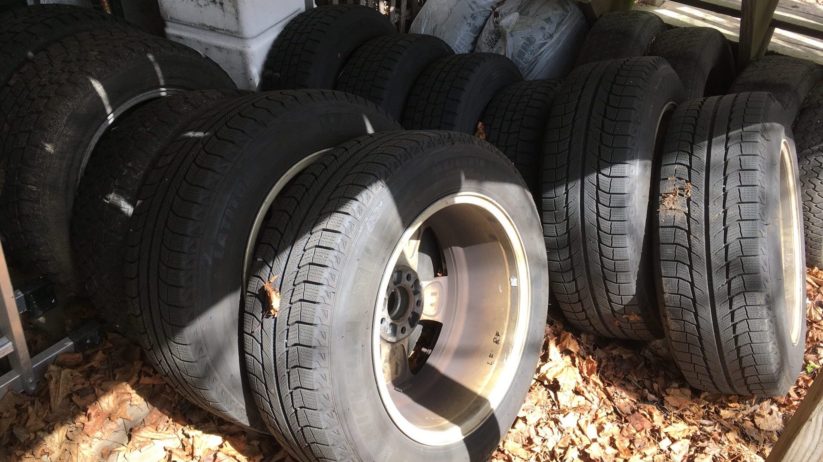My friend Andrew Wilson reports getting six inches of heavy wet snow last night in coastal Maine, the power and cable being out, and needing to run the generator. Fortunately, such a fate did not befall us in the tony wilds of West Newton (although when I went to bed and checked the weather app on my phone and it showed swirly lines, I woke up expecting spaghetti, with a chance of meatballs).
This morning it was a broken cloudy day, sunny but windy. At 45 degrees, it was a bit nippy to begin the CVV replacement in the E39, which clearly I’m avoiding anyway, so instead I engaged in that fundamental automotive rite of spring, the tire-and-wheel swap. I mean, even though we’re not really driving much of anywhere, it just goes against the laws of man and god to see soft winter rubber on a car much past the first week of April (snowstorms in coastal Maine notwithstanding).
Now, I still tend to think of myself as a kid, but as soon as I begin a wheel swap, I am instantly reminded that I am not. The wheels and tires are stored under the back porch, so I need to pull them out and roll them up the path, around the side of the house, and down the driveway. This Groucho Marx-like walk instantly angers up my lower back.
Still, what else am I going to do? Even if I took the wheels and tires to a shop to put them on, I’d have to get them into the car, and lifting them is even more work. I guess the end stage of this routine is paying one of those garages that stores them for you for the rest of the year. Scratch that: The end stage is moving to Florida and not needing to seasonally-swap them at all. That’s why I keep doing it. I’m keeping Florida at bay. Suck it, Florida.
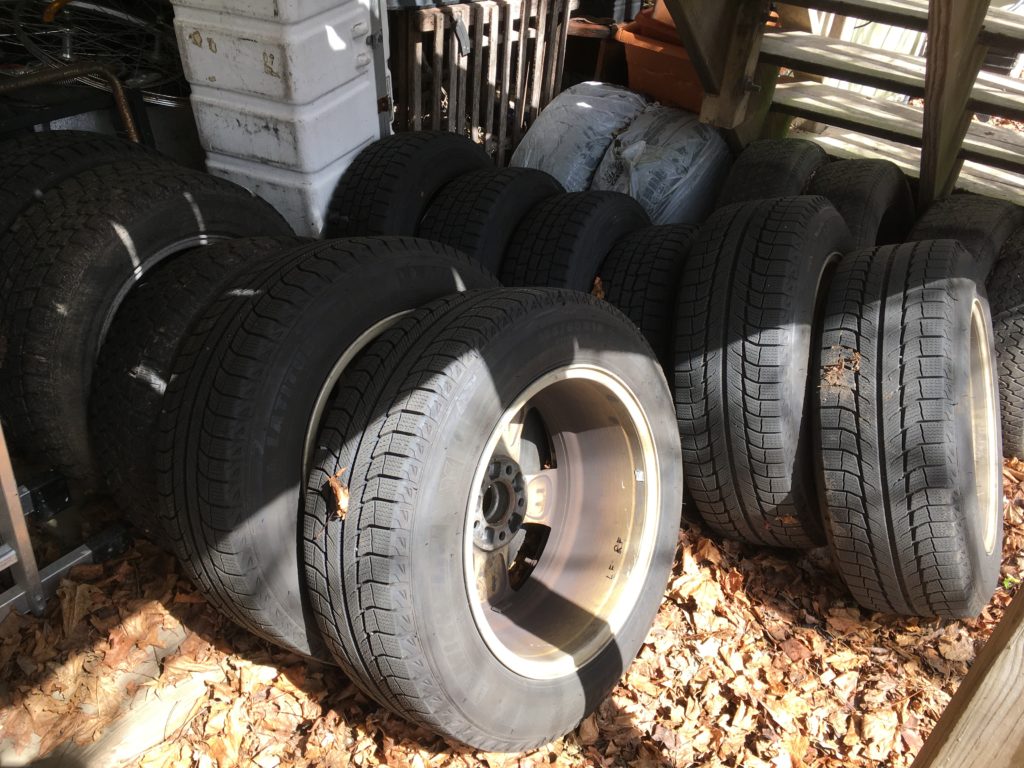
The Siegel ancestral wheel and tire stash. I joke with my kids, “Someday, all this will be yours.”
The swap patients were the X5 and my wife Maire Anne’s Honda Fit. The first question was where to perform the swap. Normally I’d pull a car into the garage, since that’s where the lift and the tools are. Putting a car on the mid-rise lift speeds the process along, and the compressor and impact wrench make short work of the lug nuts.
However, I still have the Lotus on the lift while I’m looking for a source of a small but persistent antifreeze drip, and the E9 was behind it.
I began with Maire Anne’s Honda Fit. Its little 185/70-14 winter rubber makes the wheels and tires easy, although I do need to bend down further to do the Groucho walk. There’s always a moment with the Fit when I remember that the winter and summer wheels take different nuts, requiring me to find the little cardboard box holding them, and that the summer wheels have these foolish wheel locks on them, so I need to dig the special keyed driver out of the glovebox. But this year I unearthed them all without event.
Rather than move the cars in the garage, though, I thought that I’d just do the swap on the sidewalk.
I dragged a floor jack, jack stands, and a breaker bar out of the garage, positioned the Fit so that the jack and stands would be fully on the cement sidewalk and not on the asphalt (I’m hyper-vigilant about this), and cracked the lug nuts. To my surprise, a winter’s worth of salt exposure had put a lot of corrosion onto the threads on the exposed studs, and the first three I tried removing never freed up to hand-spin off, instead requiring cranking on the ratchet wrench all the way to removal. I stopped, reconsidered, ans decided I wanted access to my air impact wrench (and, yes, made a mental note to look into one of the electric impact wrenches that I see the cool kids using), so I pulled the E9 out of the garage, freeing up that spot.
In last week’s column, I said that I planned to skooch Hampton the 48,000-mile ’73 2002 sideways on its wheel dollies and get it out of the garage for spring, but it rained most of this week, so I haven’t yet gotten around to it. This means that Hampton, as well as the line of tools and parts that have accumulated over the winter on its right, are still there. This narrows that space in the garage considerably. Still, the Fit is a little car, so there was enough room to pull in the nose, jack it up, set it on stands, and maneuver on the left and right sides to change both front wheels. I then pulled the car out, spun it around, backed it in, and did the rears. It certainly wasn’t as convenient as using the lift, but the compact size of the car and its wheels made it all pretty easy. The Fit was done quickly, the worst part of it being the Groucho walk.
Next I needed to do the X5. I tried using the same pull-just-the-nose-into-the-garage trick, but it was immediately obvious that owing to the car’s girth and the clutter around Hampton, there wasn’t enough room to comfortably sit on both sides of the car, as I’d need to do to dismount and mount the heavy eighteen-inch wheels and tires.
I temporarily positioned the car in front of the garage—I couldn’t work on it there due to both the asphalt and the fact that it’s on a hill—pulled out the hose for the air compressor from its reel as far as it could go, and used the impact wrench to loosen the lug nuts on all four wheels, which I then hand-tightened. I then backed the X5 up onto the sidewalk and had at it.
I’ve said this before, but really, it can’t be said it enough: Don’t ever crawl under a car that’s supported by only a jack. The problem is that people think, “Yeah, I’d never do that, but changing a wheel isn’t crawling under a car.” I’ll admit that I’ve been guilty of this because you think that, first, you only have one wheel of the car jacked up for a minute, and second, being “under a car” means that your torso is under the car, and when you change a wheel, it isn’t.
On a little car with small wheels like a 2002 or the Honda, I can crouch at one of the corners, lift the wheel, and set it on the hub without putting any part of myself under the car, but thatdoesn’t matter. Take the extra 30 seconds it takes to grab a jack stand, put it under a subframe or frame-rail point, and lower the jack so that they share the load.
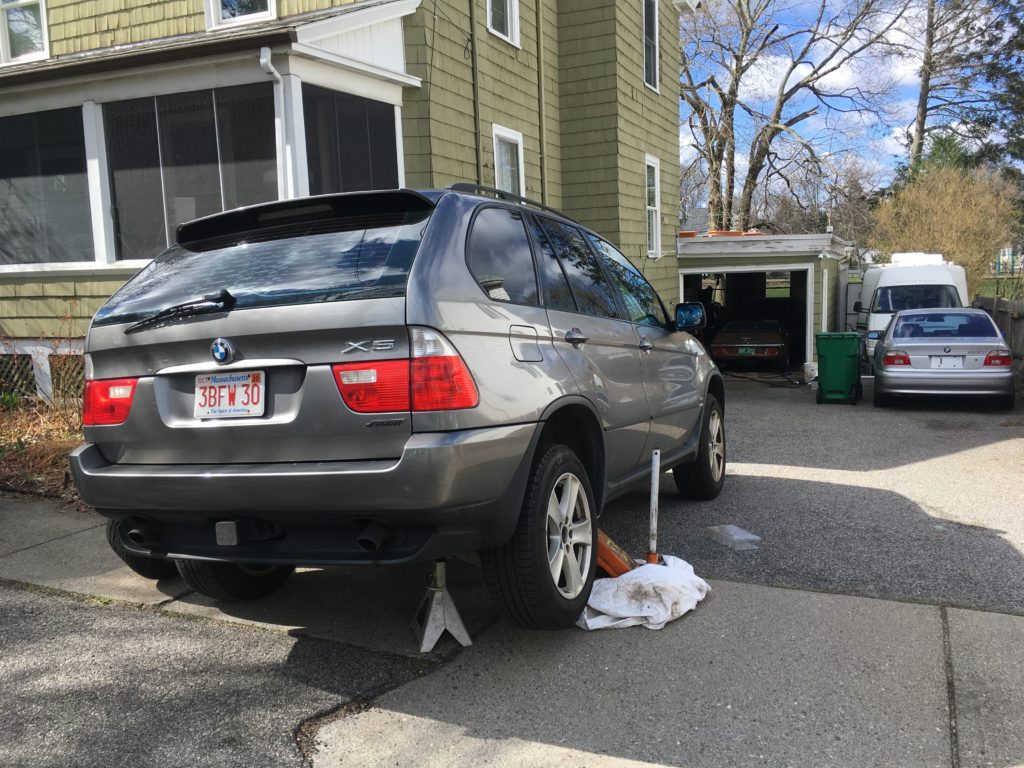
Even when jacking up one corner, you can and should double-jack a car by sharing the load with a jack stand.
Of course, on the X5, each of the eighteen-inch wheels with the Continental run-flats weighs about 60 pounds, so I do anything to avoid dead-lifting them (although, ironically, their taller size makes the Groucho walk from the backyard considerably less painful). Thus, mounting them requires sitting flat on my butt with my legs extending beneath the car and the wheel in front of me, pulling my knees together to skooch them beneath the wheel, and raising my knees to get the wheel into position on the hub. So there’s no pretending that part of me isn’t beneath the car, and thus I double-jack whenever I do this.

Assuming the position.
There were three surprises in the X5 wheel swap. The first was that the rear rotors looked like hell. When I’d bought the X5, the seller included a new set of front and rear rotors that he’d bought but hadn’t installed. He was unclear on why he’d bought them. The car shuddered badly on braking, but that was due to a bad front lower control arm, and the shuddering went away after I replaced it. I thought briefly about taking this moment to swap the rotors, but I checked the pads, they had plenty of wear left on them, and didn’t want the mission creep.

Ick.
The second was that the aluminum hub-centric rings I was using (the snows are on alloys from an E70 X5 with larger center bores) were corroded in place. I usually use anti-seize on the hubs when I swap wheels, but I guess that last winter I’d forgotten. I also realized that I usually use plastic hub-centric rings, and that the action of corrosion of dissimilar metals between these aluminum rings and the steel hubs probably exacerbated the problem. I tried to pry them off but couldn’t. Finally I tapped the edge of a screwdriver with the 1/2-inch ratchet extension to cut them (they’re very thin and cut easily) and then pried them off. I then cleaned up the hub surfaces with a Scotch-Brite pad and coated them with anti-seize.
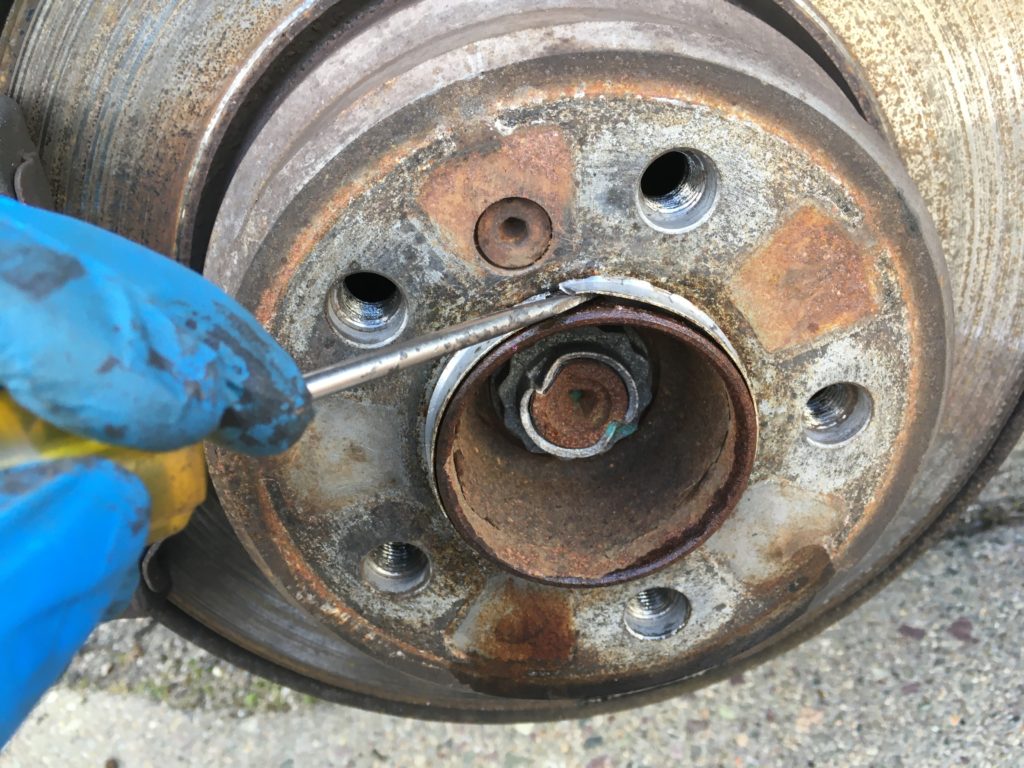
Prying off one of the corroded-in-place aluminum hub-centric rings.
Lastly, when you swap on the summer shoes, it’s always a good idea to inspect the rubber, and sure enough, I noticed a non-trivial gouge in the sidewall of one of the tires. Initially I was surprised, but I slowly remembered seeing it last fall, looking for a single replacement Continental LX20 run-flat, getting wrapped around the axle of the question of uneven tire wear, and buying a set of well-priced winter wheels and tires instead. Right now I’m not really driving the car anywhere, but I’ll begin thinking about it.
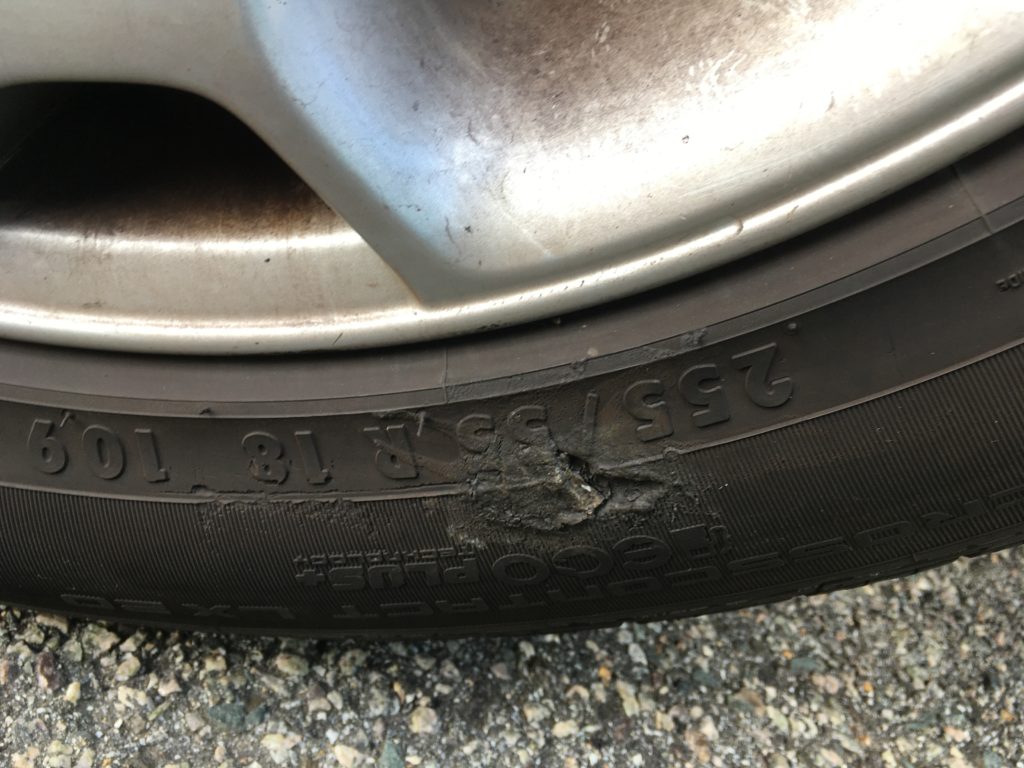
Ruh roe.
But at least it’s done. I’m happy to see the X5 on its proper stock sport wheels again. Everything else may be going to hell, but at least the cars are properly seasonally shod.
Of course, if the weather actually turns to spaghetti, I may need to switch to Pirellis. They are, after all, Italian.—Rob Siegel

Rob’s new book, Resurrecting Bertha: Buying Back Our Wedding Car After 26 Years In Storage, is available on Amazon here. His other books, including his recent Just Needs a Recharge: The Hack MechanicTM Guide to Vintage Air Conditioning, are available here on Amazon. Or you can order personally-inscribed copies of all of his books through Rob’s website: www.robsiegel.com.

